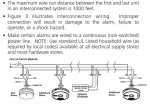jxofaltrds
Retired ESI
- Location
- Mike P. Columbus Ohio
- Occupation
- Creator
I will not win this battle however it appears to me that the manf. wants nothing interfering with the smokes.
I see no problem branching out prior to the first smoke not after that point. These are to be installed in series. I couldn't link the instruction manual however you can go here: http://www.brkelectronics.com/faqs/professionallyinstalled/how_do_i_install_hardwired_brk_alarms



I see no problem branching out prior to the first smoke not after that point. These are to be installed in series. I couldn't link the instruction manual however you can go here: http://www.brkelectronics.com/faqs/professionallyinstalled/how_do_i_install_hardwired_brk_alarms





